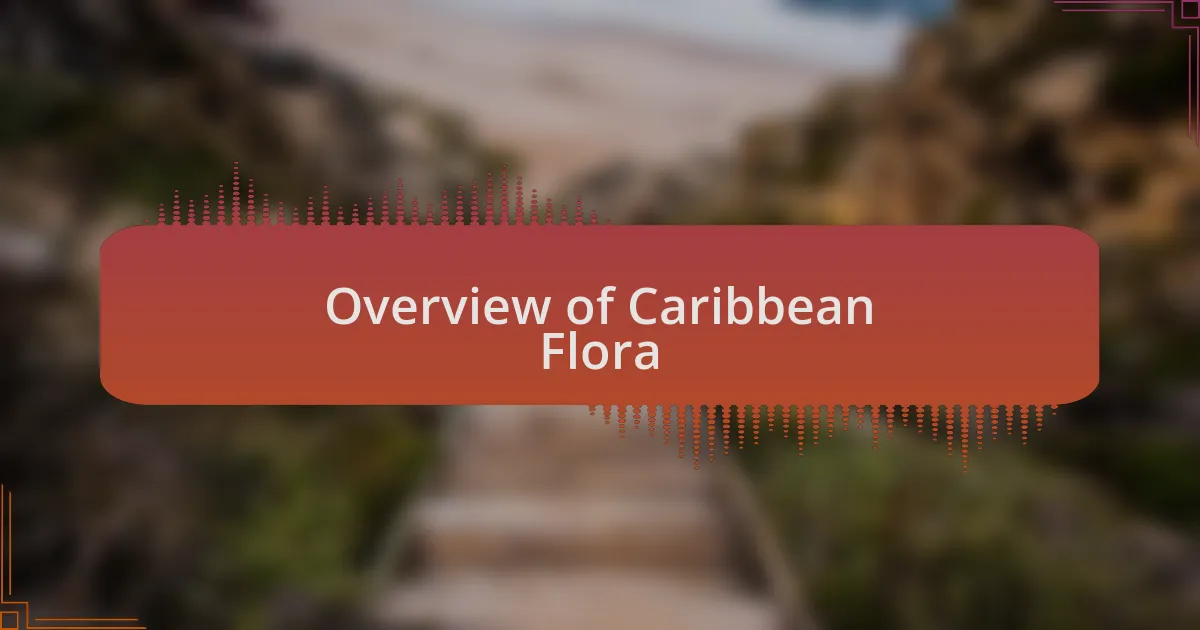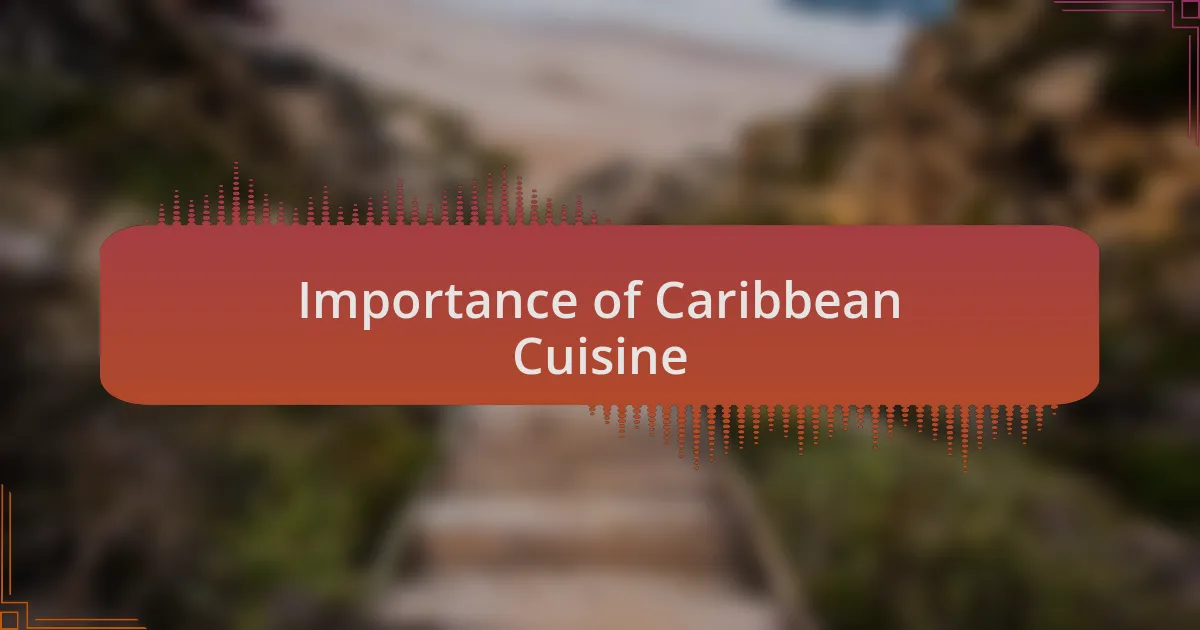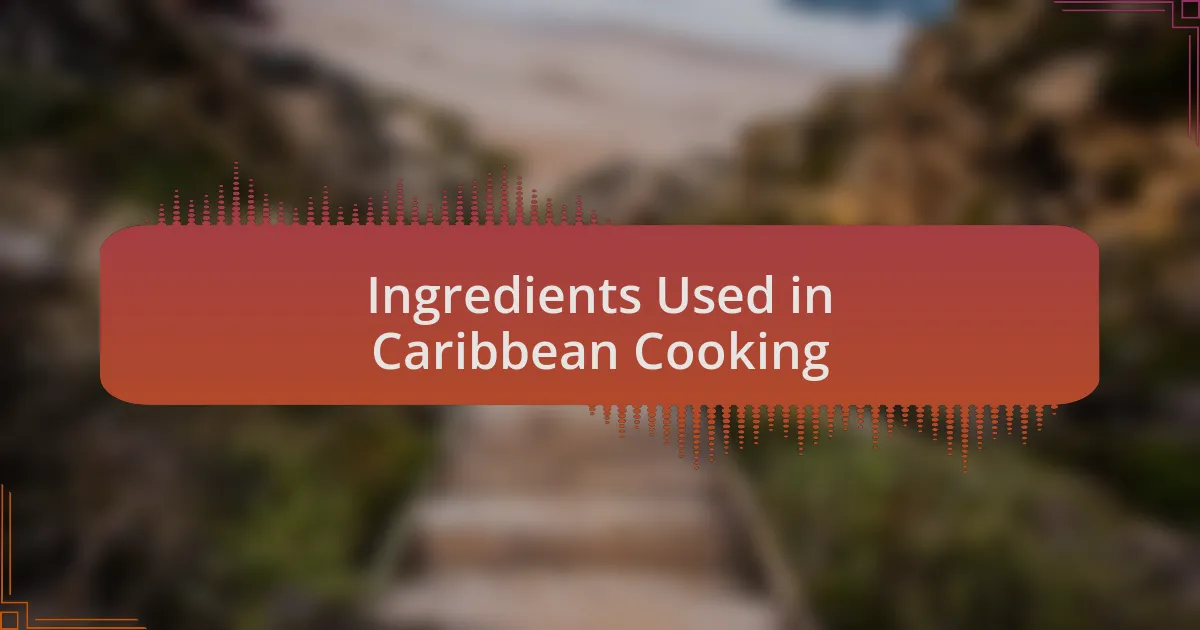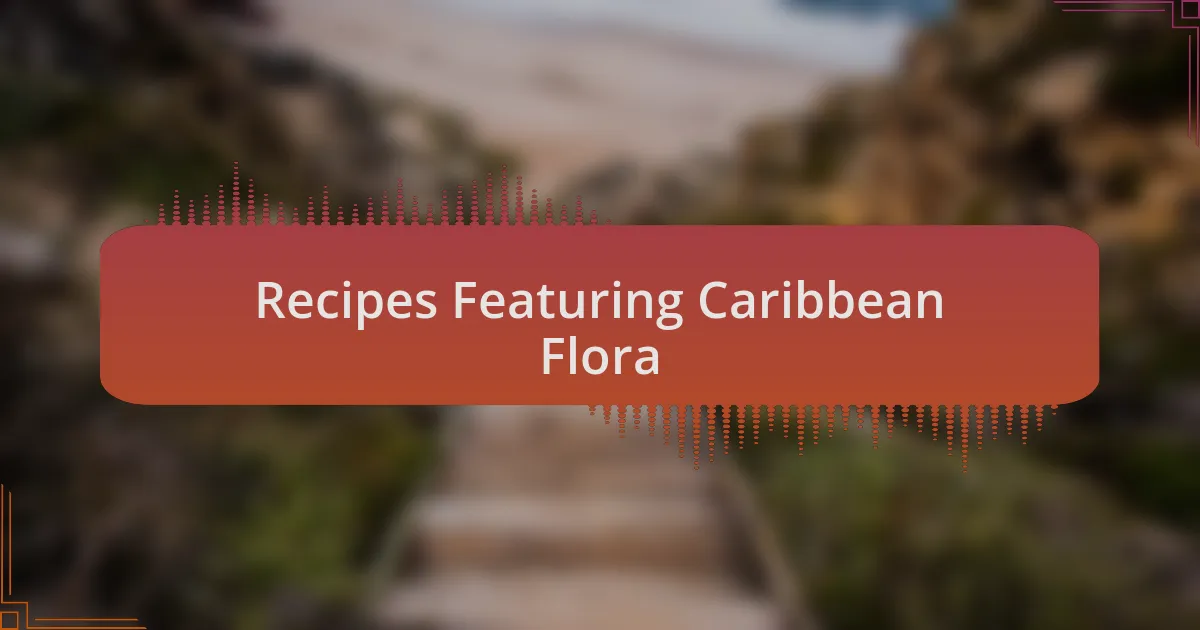Key takeaways:
- The Caribbean’s diverse flora and vibrant herbs play a crucial role in local cuisine, enhancing flavors and cultural significance.
- Caribbean cooking fosters community and togetherness, often centered around shared meals and traditional techniques.
- Experiencing local ingredients, like fresh herbs and spices, can transform dishes, evoke memories, and deepen connections to the island’s culture.
- Exploring local markets and engaging with chefs can enrich culinary exploration and reveal unique recipes and traditions.

Overview of Caribbean Flora
The Caribbean boasts an incredibly diverse range of flora, shaped by its tropical climate and varied landscapes. Venturing through lush rainforests, I remember being captivated by the vibrant colors of hibiscus flowers and the unique shapes of ferns. Have you ever touched a leaf and felt its texture tell a story of survival and adaptation?
One can’t overlook the fragrant herbs that grow abundantly in this region, such as thyme, allspice, and oregano. While cooking with fresh thyme from my own garden, I often reflect on how these humble plants contribute significantly to the rich tapestry of Caribbean cuisine. Isn’t it fascinating how a sprinkle of herb can evoke memories of family gatherings and shared meals?
Not only do the plants provide culinary delights, but they also exist in harmony with the region’s diverse wildlife. I recall hiking through a nature reserve where the sight of a mango tree, heavy with fruit, instantly drew a flock of butterflies. Isn’t it remarkable how such interactions highlight the interconnectedness of life in the Caribbean ecosystem? Each plant serves a purpose, weaving a complex web of life that enhances our understanding of nature’s beauty.

Importance of Caribbean Cuisine
Caribbean cuisine holds a special place in the hearts of those who inhabit the islands and visit them. I often think of the first time I tasted a richly seasoned jerk chicken infused with the flavors of fresh scallions and Scotch bonnet peppers. It was a moment that opened my eyes to how deeply food can reflect culture and history, connecting me to the very essence of Caribbean identity. Have you ever savored a meal so profoundly that it transported you to another place?
The importance of Caribbean cuisine goes beyond taste; it fosters community and togetherness. I remember sharing a hearty bowl of callaloo soup at a local festival, surrounded by laughter and music. Each spoonful seemed to carry the stories of generations, showcasing how traditional cooking techniques and local ingredients unite families and friends. Isn’t it incredible how food can create bonds that transcend time and place?
Moreover, Caribbean cuisine emphasizes sustainability and the use of local resources, which is vital in today’s world. When I began experimenting with seasonal produce from local farmers’ markets, I discovered new flavors and combinations that inspired my cooking. This relationship with the land not only supports the economy but also honors the heritage of the islands. Have you ever thought about the impact your food choices have on the environment? Embracing these principles within Caribbean cooking can lead to a more sustainable future, preserving both the land and the culture.

Exploring Flora in Cooking
Exploring the flora utilized in Caribbean cooking is like embarking on an adventure into a vibrant tapestry of flavors. I recall the first time I picked fresh thyme from a local garden; the aroma enveloped me, igniting a sense of connection to my culinary roots. Have you ever experienced a smell that instantly transported you to a specific moment in time? It made me realize how vital these herbs and plants are in crafting dishes that tell our stories.
There’s something magical about incorporating local fruits into everyday recipes. For example, I once made a mango salsa that perfectly paired with grilled fish. The sweetness of the ripe mangoes combined with hot pepper and lime was nothing short of a revelation. I often wonder, how can such simple ingredients create a symphony of flavors that dance on the palate? It’s a testament to how the Caribbean landscape offers a world of culinary possibilities just waiting to be explored.
In my journey, I’ve discovered the diverse uses of edible flowers, such as hibiscus. I started steeping hibiscus petals to make a refreshing tea, only to realize later that the same flowers could beautify my salads. The bold crimson color added visual flair, turning an ordinary dish into a feast for the eyes. Isn’t it fascinating how one ingredient can play multiple roles in our cooking? The flora of the Caribbean truly enriches not just our meals, but also the experience of cooking itself.

Ingredients Used in Caribbean Cooking
When it comes to Caribbean cooking, one can’t overlook the robust use of spices that elevate each dish. I still remember my first time using allspice, also known as pimento. The warm, sweet aroma it released as I sprinkled it over my stew was a revelation. It sparked an immediate connection to the lush landscapes of Jamaica, where the spice grows abundant. Isn’t it interesting how a single spice can evoke such vivid imagery and flavor in our minds?
Then there are the vibrant peppers, like Scotch bonnet, that pack a punch. I was hesitant at first, intimidated by their reputation for heat. But after cooking with them in a jerk marinade, I understood why they are a staple. The flavor was complex—fruity yet fiery—and it lingered in a way that left me craving more. It got me thinking: how can a small pepper change the entire experience of a meal and transport you to the Caribbean in an instant?
Don’t even get me started on the many types of root vegetables that grace our tables, such as cassava and sweet potatoes. The first time I roasted cassava, my family’s faces lit up with delight. The crispy edges and soft center reminded us of home, evoking nostalgia with every bite. I ask myself often, how do these simple ingredients carry such powerful memories? It’s a beautiful reminder of how food intimately connects us to our past and to each other.

Personal Journey in Caribbean Cooking
In my journey through Caribbean cooking, I found myself captivated by the importance of fresh herbs. One afternoon, on a trip to a local market, the scent of cilantro caught my attention. I had never considered how a handful of fresh herbs could transform a simple fish dish into a vibrant feast. As I chopped, I could almost hear the gentle waves lapping against the shore, drawing me further into the culture behind the cuisine.
There was a moment when I decided to experiment with coconut milk in a curry. I was surprised by the creamy texture and rich flavor it added. Watching the mixture bubble away on the stove, I felt a wave of nostalgia for summers spent in the Caribbean, where the sweetness of coconut and the coastline were inseparable. Isn’t it amazing how a cooking choice can evoke such deep feelings and memories?
As I explored further, I realized the role of communal cooking in the Caribbean. I vividly recall a family gathering where we all participated in making a large pot of callaloo. The laughter and chatter filled the air, and I understood then that cooking wasn’t just about the food; it was about bonding over shared experiences. This made me ponder, isn’t the essence of Caribbean cooking found in the connections we create with one another around the table?

Recipes Featuring Caribbean Flora
One of my favorite recipes incorporates the vibrant flavors of Caribbean peppers. I remember the first time I used Scotch Bonnet peppers in a jerk chicken marinade. The spicy kick transformed the dish entirely, creating an experience that danced on my palate. Have you ever tasted something so exhilarating that it sparked memories of warm island breezes and lively music?
Another culinary gem I discovered is using hibiscus flowers in a refreshing drink. After steeping the dried petals in boiling water, I mixed them with fresh lime juice and sugar. The resulting tart, ruby-red beverage was not just thirst-quenching; it brought a splash of tropical color to any gathering. I still think about how one unique ingredient can elevate a simple drink and create an unforgettable moment for friends around the table.
I also love adding fresh thyme to my dishes. I distinctly recall preparing a seafood stew with plenty of fresh herbs, including thyme, from my garden. The aroma wafting through my kitchen reminded me of the lush landscapes of the Caribbean. It’s incredible how a dash of herb can provide depth and connection to the land, don’t you think? This simple addition serves as a reminder that every ingredient tells a story, inviting us to savor not just the flavors but the experiences that come with them.

Tips for Culinary Exploration
When delving into Caribbean ingredients, I recommend visiting local markets if you have the chance. On my last trip, wandering through colorful stalls, I stumbled upon a vendor selling freshly picked mangoes. The vibrant aromas and faces of the locals sharing their favorite recipes transformed simple shopping into an unforgettable culinary adventure. Have you ever had that feeling of discovery, where every corner hides a new flavor waiting to be discovered?
Another tip is to experiment with herbs and spices that are unique to the region. I remember the first time I added allspice to a fish dish – it turned a familiar recipe into something exotic and delightful. Allspice is like a time capsule of flavors, capturing nutmeg, cinnamon, and cloves all at once. By using these spices, you not only diversify your dishes but also connect with the rich cultural tapestry of the Caribbean.
Don’t shy away from asking locals for their cooking secrets. During one of my journeys, a chef invited me into her kitchen to learn her special method for making rice and peas. The warmth of her hospitality, combined with her detailed instructions, left me with not just a new recipe but also a cherished memory. Isn’t it magical how sharing food connects us, bridging cultures through flavors and traditions?